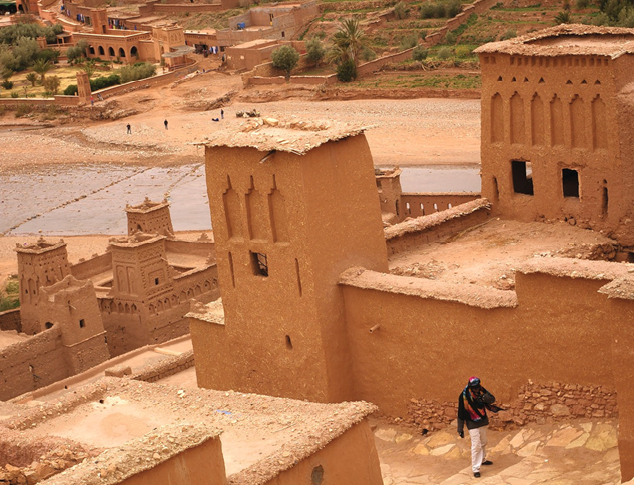Our travel writer Ramdas Iyer explores the ancient, Sunbaked Ksours, Kasbahs and Vernacular mud architecture in the region South of Marrakesh.
Ksours form part of the typical desert landscape in most countries of North Africa. Some of them have become famous thanks to the sci-fi or historical films shot there, for example, Matmata in Tunisia was the site for Star Wars, Ait Benhaddou in Morocco for Kingdom of Heaven and Gladiator, and scores of other productions. In southern Morocco, across the area between the Ziz and Drâa rivers, there are around 600 ksours and more than 400 kasbahs, forming what is known as the Route of 1,000 Kasbahs.
Ksour (qasr in Arabic) are fortified villages including houses, grana- ries, cemeteries and a mosque. Kasbahs are fortified palaces belonging to a single family with their own granaries, water sources, and places of worship. The first ksours were built as early as the 11th century and the indigenous inhabitants of ksour regions are of Berber origin, pri- marily residing in Morocco and Algeria.
My interest in vernacular mud architecture has taken me to many parts of the dry Saharan environment.
The High Atlas Mountain chain divides Morocco into two distinct parts. The area of ample rainfall, bountiful agriculture and placid vil- lage life to the north was historically called bled al-makhzan, the land of imperial governance. To the south, a rocky, sandy and sunbaked expanse stretched into the Sahara. This was bled es-siba, known as the land of disorder.
Loading...
While most typical Moroccan travel itineraries include the imperial cities of Fes, Meknes and Rabat in the north along with the Mediterranean beaches at Agadir, little attention has been paid to the Saharan south. So, I decided to explore this amazing region south of Marrakesh across the snowcapped High Atlas passing through Ouarzazate, home to the World Heritage site, Ait Benhaddou , all the way to Zagora, home to high dunes where an old sign of dubious origin reads, ‘52 days to Timbuktu’, a journey to be undertaken on a camel.
Abdeslam Mesbahi, my well-informed driver and guide, made this trip a historically-oriented one. His ability to speak in English, French, Arabic and Tamazight (Berber language) with equal ease helped in our frequent interactions with the locals.
Set among the ancient caravan routes that traded goods from sub-Saharan Africa to the Mediterranean coast to cities like Marrakech and Essaouira, kasbahs and ksours dot the main route for over a distance of 150 kilometers. Today, most of the mud buildings are in extremely poor condition due to the emigration of people to the cities.
Yet, many of them have been restored, including the magnificent Ait Benhaddou; Tamadot Kas- bah, owned by British billionaire-entrepreneur Richard Branson; and the recently-renovated Taourirt Kasbah, a 300-room citadel with a maze of narrow passageways, steeped towers and narrow staircases. I was fortunate to stay in a small kasbah across the street from Taourirt and was given a tour of the compound where many Ber- ber families still live in unrestored, ruined apartments.
Mesbahi gave me a detailed account of the evolution of these amazing mud structures. Ksours are typically medieval towns characteristic of Saharan settlements well-integrated into their natural environment. During medieval times, the local population consisted of two main social groups; nomads making a living through trade and pasturage, and the landowners along with their workers who lived in the oases that dotted the countryside.
While both groups were dependent on each other, conflicts report- edly arose when the nomads engaged in uncontrolled pasturage in the oases, which deprived the inhabitants of harvest. It became the main reason for conflict between the settled tribal and nomad groups, and this meant frequent raids on the granaries.
One of the ways to prevent such attacks was to build fortified granaries. As attacks could occur quite unexpectedly and last for extended periods, the ksours were prepared for the “normal” life of their inhabitants. Apart from granaries, and spaces for living, they all featured a mosque, markets and schools. Ait Benhaddou is perhaps the most spectacular of all ksours. The walls are built with local mudbricks and the roofs made using the trunks and branches of palm trees make them truly eco-friendly.
Like most vernacular architecture in Africa, the need for stable employment, better living conditions and access to education have emp- tied these structures. Without regular upkeep, they collapse after the rains, and it broke my heart to see the entire region filled with ruined structures running for miles along oasis towns.
Tourism has helped restore some of the major buildings, but many classical structures are being relegated to architectural textbooks. The occasional traveler like me yearns for a glimpse into this ancient world. But alas, it is the Maghreb’s last sigh!
Loading...
